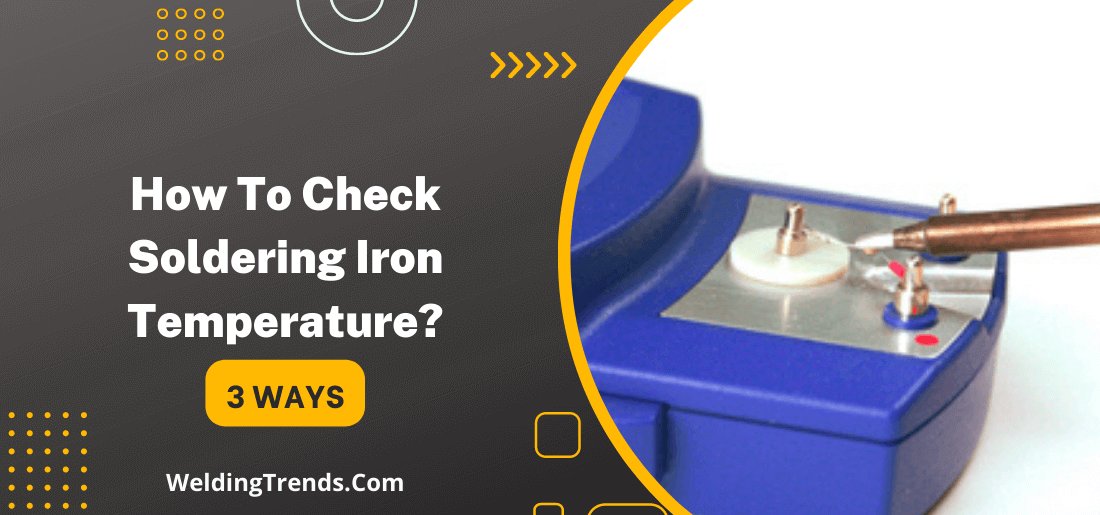Soldering irons are essential tools for electronics hobbyists and professionals. It is important to select the right soldering iron for your needs and to use it correctly to get the best results.
When it comes to using a soldering iron, you want to make sure that the temperature is just right to create a strong and secure solder joint.
In this blog post, we will show you how to check your soldering iron’s temperature so that you can get the results you are looking for. Stay tuned!
3 Ways To check soldering iron Temperature
There are a few different ways that you can check the temperature of your soldering iron:
1. Use an infrared thermometer: This is the most accurate way to check the temperature of your soldering iron. Simply point the thermometer at the tip of the iron and take a reading.
2. Use a multimeter: Most multimeters have a built-in temperature function that can be used to measure the temperature of your soldering iron. Simply touch the probes of the multimeter to the tip of the iron and take a reading.
3. Use a temperature-sensitive sticker: These stickers change color at a certain temperature, so you can place one on the tip of your soldering iron and wait for it to change color to get an approximate idea of the temperature.
Once you have checked the temperature of your soldering iron, you can adjust it as needed to get the desired results. When it comes to soldering, the general rule of thumb is that the higher the temperature, the better.
However, you don’t want to overdo it, as this can damage the components you are trying to solder. If you are new to soldering, we recommend starting with a lower temperature and working your way up until you find the sweet spot.
Once you have found the perfect temperature for your needs, be sure to stay consistent with it to get the best results.
Now that you know how to check the temperature of your soldering iron, you are one step closer to becoming a soldering pro!
Also Read: What Metals Can Be Soldered?
Tips for keeping soldering iron at correct temperature
1. Use a soldering station: A soldering station is a great way to keep your soldering iron at a consistent temperature. Simply set the temperature on the station and let it do its job.
2. Use a temperature-controlled soldering iron: These irons have a built-in mechanism that helps to regulate the temperature, making it easier to keep things consistent.
3. Use a soldering iron with a ceramic tip: Ceramic tips retain heat better than other types of tips, so they can help to keep the temperature of your soldering iron more consistent.
4. Use a tip-temperature monitor: These devices attach to the tip of your soldering iron and provide constant feedback on the temperature, so you can make adjustments as needed.
5. Use a quality soldering iron: A high-quality soldering iron will maintain a consistent temperature better than a cheap one, so it is worth investing in a good quality iron if you plan on doing a lot of soldering.
following these tips, you can be sure that your soldering iron is always at the correct temperature, making it easier to get great results.
Safety precautions when using a soldering iron
When using a soldering iron, it is important to take some safety precautions.
- First, always use the soldering iron in a well-ventilated area.
- Second, be sure to wear gloves and eye protection when using the soldering iron.
- Third, never touch the tip of the soldering iron to your skin.
- Finally, always unplug the soldering iron when you are finished using it.
By following these simple safety precautions, you can avoid injury when using a soldering iron.
Troubleshooting tips if your soldering iron isn’t heating up properly
If your soldering iron isn’t heating up properly, there are a few things you can try:
1. Check the power supply: Make sure that the power supply is plugged in and turned on. If it is, check to see if the power light is illuminated.
2. Check the temperature setting: If your soldering iron has temperature control, make sure that it is set to the correct setting.
3. Check the tip: If the tip of your soldering iron is dirty, it can impede heat transfer and cause the iron to take longer to heat up. Use a damp sponge or cloth to clean the tip.
4. Check for shorts: If there is a short in the power cord or elsewhere, it can cause the soldering iron to heat up slowly or not at all. Check for signs of damage and replace any damaged parts.
5. Check the heating element: In some cases, the heating element may be faulty and will need to be replaced. This is usually not a DIY job and will require the help of a professional.
If you have tried all of these troubleshooting tips and your soldering iron still isn’t heating up properly, it may be time to buy a new one.
FAQs – check soldering iron temperature
How do you measure soldering temperature?
The most common way to measure temperature for soldering purposes is with a thermocouple. A thermocouple consists of two wires made of different metals that are joined together at one end.
The junction between the two wires creates a voltage that is proportional to the difference in temperature between the two ends of the wires. Thermocouples are relatively inexpensive and can be used to measure a wide range of temperatures, making them well suited for soldering applications.
What temperature is a soldering iron?
The temperature of a soldering iron can range from 200 to 450 degrees Celsius. The most common temperatures used for soldering are between 350 and 400 degrees Celsius.
How can I get better at soldering?
There’s no one answer to that question since everyone has different strengths and weaknesses.
However, here are some general tips that may help you improve your soldering skills:
- Practice, practice, practice! The more you solder, the better you’ll get at it.
- Pay attention to your technique. Make sure you’re using the right amount of heat and pressure and that your solder joint is clean and smooth.
- Use quality tools and materials. Good soldering iron and fresh, high-quality solder will make a big difference.
- If you’re having trouble with a particular joint, try watching a tutorial or two on soldering to see if you can pick up some helpful tips.
Can you solder without flux?
No, it is not recommended to be sold without flux as it can lead to poor connection and an overall weaker joint. Flux also helps to prevent oxidation of the metals being joined.
What temperature does solder melt?
The melting point of solder is generally between 400 and 450 degrees Fahrenheit. However, the specific melting point will depend on the alloy used.
Some alloys of solder have a lower melting point than others. For example, lead-free soldiers generally have a melting point that is about 100 degrees Fahrenheit higher than traditional lead-based soldiers.
The melting point of solder is also affected by the presence of other metals. For example, adding tin to lead-based solder will lower the melting point.
Final Words
Soldering irons come in all shapes and sizes, but no matter which one you’re using, it’s important to make sure that it’s set at the right temperature for whatever project you’re working on. There are a few different ways to check the temperature of your soldering iron.
By using one of these methods to test Iron Temperature, you can be sure that your projects will turn out looking great (and staying intact!)




